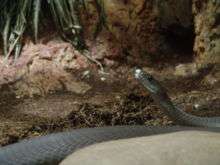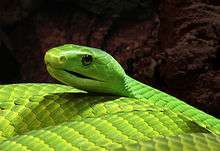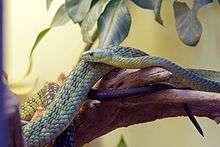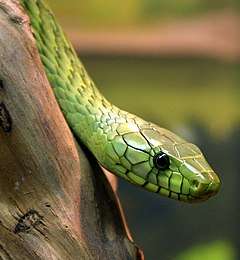Mamba
Mambas are fast moving venomous snakes of the genus Dendroaspis (which literally means "tree asp") in the family Elapidae. Four extant species are recognised currently; three of those four species are essentially arboreal and green in colour, whereas the so-called black mamba, Dendroaspis polylepis, is largely terrestrial and generally brown or grey in colour. All are native to various regions in sub-Saharan Africa and all are feared throughout their ranges, especially the black mamba. In Africa there are many legends and stories about mambas.[2][3][4]
| Mamba | |
|---|---|
 | |
| Black mamba | |
| Scientific classification | |
| Kingdom: | Animalia |
| Phylum: | Chordata |
| Class: | Reptilia |
| Order: | Squamata |
| Suborder: | Serpentes |
| Family: | Elapidae |
| Subfamily: | Elapinae |
| Genus: | Dendroaspis Schlegel, 1848 [1] |
| Species | |
| |
Behaviour
The three species of mambas are arboreal, whereas the black mamba is largely terrestrial.The black mamba is one of the largest and most venomous in Africa. All four species are active diurnal hunters, preying on birds, lizards, and small mammals. At nightfall some species, especially the terrestrial black mamba, shelter in a lair. A mamba may retain the same lair for years.
Mambas and cobras are in the same family: the Elapidae. Like cobras, a mamba may rear and form a hood as part of its threat display, but the mamba's hood is narrower and is longer than the broader hood of some species of cobra, such as say, the spectacled cobras of parts of Asia. In their threat display mambas commonly open their mouths; the black mamba's mouth is black within, which renders the threat more conspicuous. Typically also, a rearing mamba tends to lean well forward, instead of standing erect as a cobra does.
Stories of black mambas that chase and attack humans are common, but in fact the snakes generally avoid contact with humans.[5] Most apparent cases of pursuit probably are examples of where witnesses have mistaken the snake's attempt to retreat to its lair when a human happens to be in the way.[6] The black mamba usually uses its speed to escape from threats, and humans actually are their main predators, rather than prey.[2]
Venom

All mambas are highly venomous. Their venoms consist mostly of neurotoxins (known as dendrotoxins). Besides the neurotoxins, they also carry cardiotoxins[2][7] and fasciculins.[8][9] Other components may include calcicludine, which is a known component of the eastern green mamba's venom and calciseptine, which is a component of black mamba venom. Toxicity of individual specimens within the same species and subspecies can vary greatly based on several factors, including geographical region. Even the weather and altitude can influence toxicity (Ernst and Zug et al. 1996). A bite can be fatal to humans without access to proper first aid and subsequent antivenom treatment, as it shuts down the lungs and heart. The western green mamba (D. viridis), eastern green mamba (D. angusticeps), and Jameson's mamba (D. jamesoni) possess venom similar in composition and effects to that of the black mamba (D. polylepis). However, as their venoms are less toxic (based upon LD50 studies), and their temperaments generally not as aggressive or as explosive when provoked, and as none of the three injects as much venom as the black mamba, their bites are materially less dangerous.
Before antivenom was available, envenomations by mambas carried a high fatality rate. Untreated black mamba bites have a mortality rate of 100%,[5][10] but presently, fatalities have become much rarer due to wide availability of antivenom.
Mamba toxins
Mamba toxin (or dendrotoxin) consists of several components, with different targets. Examples are:
- Dendrotoxin 1, which inhibits the K+ channels at the pre and post-synaptic level in the intestinal smooth muscle. It also inhibits Ca2+-sensitive K+ channels from rat skeletal muscle‚ incorporated into planar bilayers (Kd = 90 nM in 50 mM KCl).[11])
- Dendrotoxin 3, which inhibits acetylcholine M4 receptors.[12]
- Dendrotoxin 7, commonly referred to as muscarinic toxin 7 (MT7) inhibits acetylcholine M1 receptors.[12]
- Dendrotoxin K, structurally homologous to Kunitz-type proteinase inhibitors [13] with activity as a selective blocker of voltage-gated potassium channels [14]
Taxonomy
Dendroaspis, derives from Ancient Greek déndron (δένδρον), meaning "tree",[15] and aspis (ασπίς), which is understood to mean "shield",[16] but also denotes "cobra" or simply "snake", in particular "snake with hood (shield)". Via Latin aspis, it is the source of the English word "asp". In ancient texts, aspis or asp often referred to the Egyptian cobra (Naja haje), in reference to its shield-like hood.[17] Thus, "Dendroaspis" literally means tree asp, reflecting the arboreal nature of most of the species within the genus. The genus was first described by the German ornithologist and herpetologist Hermann Schlegel in 1848.[18] Evidence suggests that Dendroaspis, Ophiophagus, Bungarus, and Hemibungarus form a solid non-coral snake Afro-Asiatic clade.[19]
Of the currently recognized mamba species, three are green and the other is the "black mamba", so called in spite of its generally brown or grey body.
Range and characteristics
Black mambas live in the savannas and rocky hills of southern and eastern Africa. They are Africa's longest venomous snake, reaching up to 14 feet in length, although 8.2 feet is more the average. They are also among the fastest snakes in the world, slithering at speeds of up to 12.5 miles per hour.[2][6]
* Including the nominate subspecies.
T Type species.
Notes
- A binomial authority in parentheses indicates that the species was originally described in a genus other than Dendroaspis.
References
- "Dendroaspis". Integrated Taxonomic Information System. Retrieved 30 October 2012.
- "National Geographic (Black Mamba, Dendroaspis polylepis)". National Geographic Society. Retrieved 5 July 2013.
African myths exaggerate their capabilities to legendary proportions; Black mambas are shy and will almost always seek to escape when confronted.
- Jan Knappert (1 January 1985). Myths and Legends of Botswana, Lesotho, and Swaziland. Brill Archive. pp. 53–. ISBN 90-04-07455-4.
- Alfred Burdon Ellis (1887). South African Sketches. Chapman and Hall, Limited. also at:
- O'Shea, Mark (2005). VENOMOUS SNAKES OF THE WORLD. multiple places: US and Canada: Princeton University Press; Europe: New Holland (UK) Ltd. pp. 78–79. ISBN 978-0-691-15023-9.
...in common with other snakes they prefer to avoid contact;...Of the three species of green mambas...;...from 1957 to 1963...including all seven black mamba bites - a 100 per cent fatality rate
- The new encyclopedia of Reptiles (Serpent). Time Book Ltd. 2002.
- van Aswegen G, van Rooyen JM, Fourie C, Oberholzer G. (May 1996). "Putative cardiotoxicity of the venoms of three mamba species". Wilderness & Environmental Medicine. 7 (2): 115–21. doi:10.1580/1080-6032(1996)007[0115:PCOTVO]2.3.CO;2. PMID 11990104.CS1 maint: uses authors parameter (link)
- Fasciculin
- "Neurotoxins in Snake Venom". Retrieved 2019-12-26.
- Davidson, Terence. "IMMEDIATE FIRST AID". University of California, San Diego. Archived from the original on 2012-11-02. Retrieved 2011-09-22.
- Newitt RA, Houamed KM, Rehm H, Tempel BL. (1991). "[Potassium channels and epilepsy: evidence that the epileptogenic toxin, dendrotoxin, binds to potassium channel proteins.]". Epilepsy Research Supplement. 4: 263–73. PMID 1815606.CS1 maint: uses authors parameter (link)
- Rang, H. P. (2003). Pharmacology. Edinburgh: Churchill Livingstone. p. 139. ISBN 0-443-07145-4.
- Berndt KD, Güntert P, Wüthrich K. (5 December 1993). "[Nuclear magnetic resonance solution structure of dendrotoxin K from the venom of Dendroaspis polylepis polylepis.]". Journal of Molecular Biology. 234 (3): 735–50. doi:10.1006/jmbi.1993.1623. PMID 8254670.CS1 maint: uses authors parameter (link)
- Harvey AL, Robertson B. (2004). "Dendrotoxins: structure-activity relationships and effects on potassium ion channels". Curr. Med. Chem. 11 (23): 3065–72. doi:10.2174/0929867043363820. PMID 15579000.CS1 maint: uses authors parameter (link)
- "dendro-". Collins English Dictionary - Complete & Unabridged 10th Edition. HarperCollins Publishers. Retrieved 4 March 2014.
- "Definition of "aspis" - Collins English Dictionary". collinsdictionary.com. Retrieved 15 February 2015.
- "aspis, asp". Dictionary.com Unabridged. Random House. Retrieved 4 March 2014.
- "Dendroaspis". Integrated Taxonomic Information System. Retrieved 9 December 2013.
- Castoe, TA; Smith, EN; Brown, RM; Parkinson, CL (2007). "Higher-level phylogeny of Asian and American coralsnakes, their placement within the Elapidae (Squamata), and the systematic affinities of the enigmatic Asian coral snake Hemibungarus calligaster (Wiegmann, 1834)" (PDF). Zoological Journal of the Linnean Society. 151 (4): 809–831. doi:10.1111/j.1096-3642.2007.00350.x. Retrieved 26 April 2014.
- "Dendroaspis". Integrated Taxonomic Information System. Archived from the original on 12 March 2009. Retrieved 5 July 2013.

.jpg)
